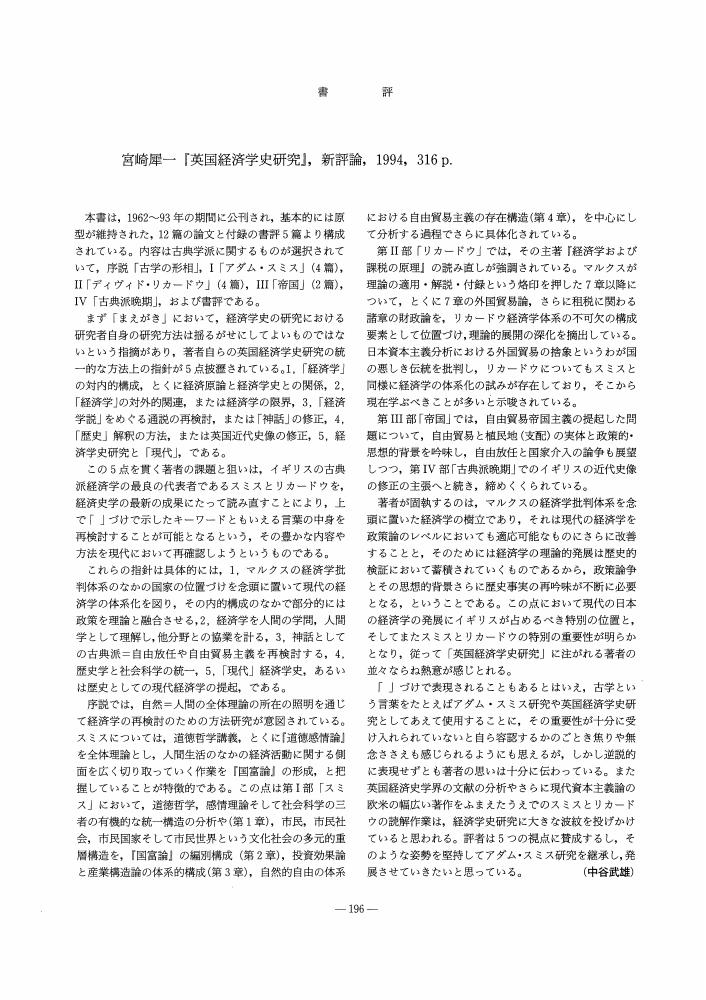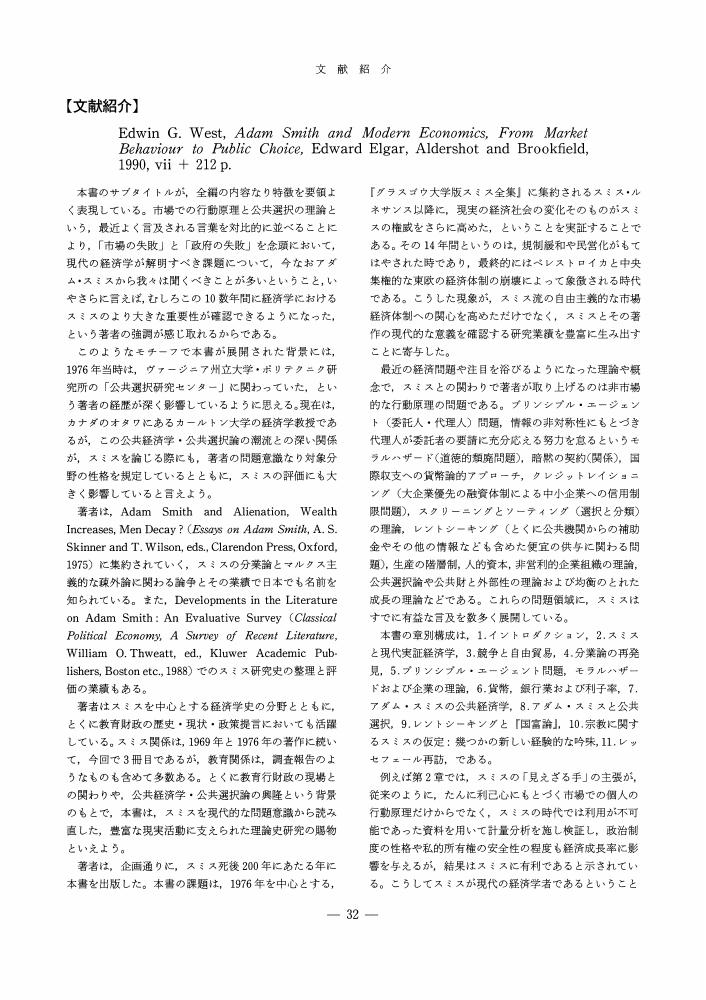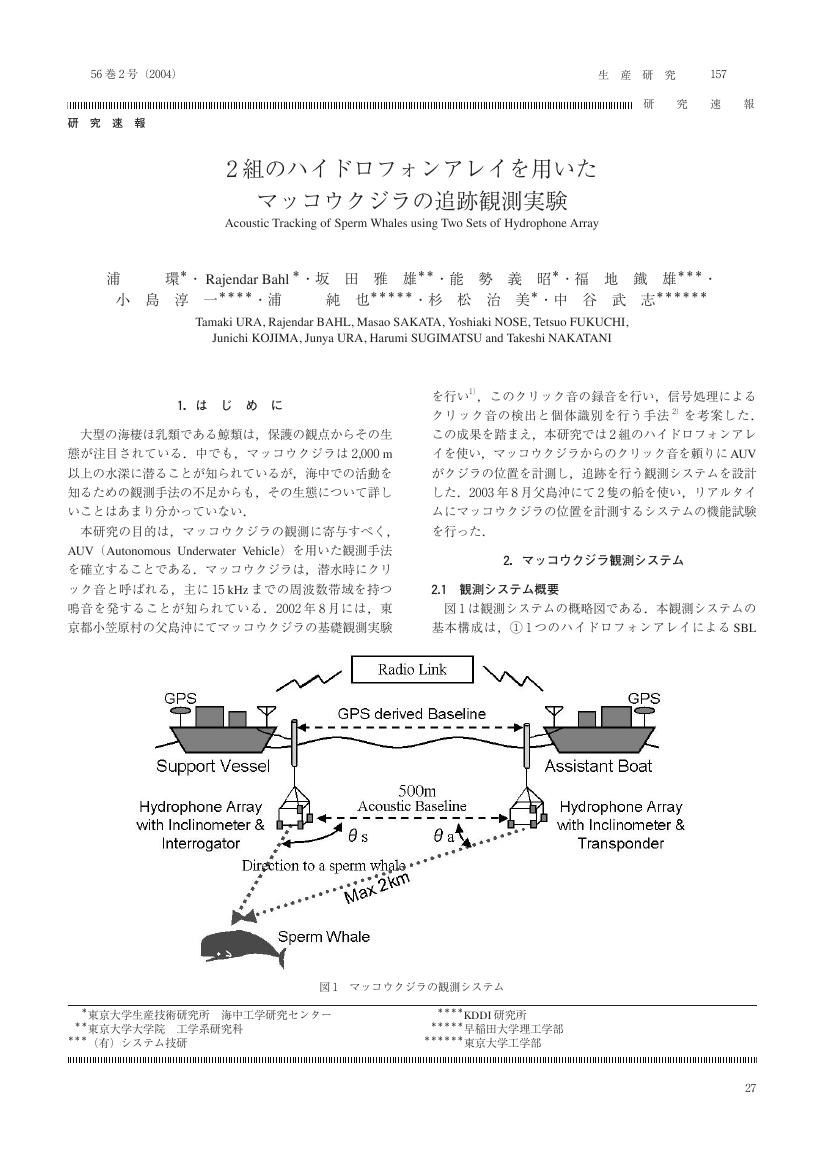- 著者
- 中谷 武雄
- 出版者
- Japan Association for Cultural Economics
- 雑誌
- 文化経済学 (ISSN:13441442)
- 巻号頁・発行日
- vol.1, no.3, pp.93-94, 1999-03-31 (Released:2009-12-08)
- 著者
- 中谷 武
- 出版者
- 経済理論学会
- 雑誌
- 季刊経済理論 (ISSN:18825184)
- 巻号頁・発行日
- vol.46, no.4, pp.6-14, 2010-01-20 (Released:2017-04-25)
This paper attempts to evaluate the significance of wage-led economy of Post Keynesian economics. In order to achieve longterm sustainable economic growth under the low growth and the environmental constraints, the switch from profit-led economy to wage-led economy will be effective and also inevitable. The main points are as follows: 1) Our current economic crisis can not be resolved by simply resuming the Keynesian demand policies in face of environmental constraints, growing fiscal deficits and low birthrate and an aging population. What is important is that we have to consider both demand side and supply side simultaneously, which mutually interrelate in determining the output and employment levels. The supply side of Keynesian theory is the core of the issue, which is neglected for long because Keynes himself disregarded it. The main stream economics has picked up this point and criticized Keynes but falsely. 2) There are three ways to shift the supply curve downwards: (1) technical improvement, (2) cutting labor cost and (3) cutting profit margin. The ways employed by neo-liberals which are theoretically based on the main stream economics since eighties are the first and the second ones, whose effectiveness has shown to be restrictive because they shift the demand curve downwards as well as supply curve. In this sense the supply side policies are rebelled against by demand side; consumption demand is sharply depressed by deteriorating expectation in future wages and employment insecurity. On the other hand, the wage-led economy is to pursue the third way of downwards shift of supply curve. 3) The possibility of wage-led economy depends on both characteristics of investment and saving functions. We can say firstly that under the condition of low economic growth the characteristics of saving function become more important compared with those in investment function, secondly that a lower saving rate of laborers leads to greater possibility of wage-led economy, and thirdly that a more progressive tax system makes wage-led economy more possible. These Post Keynesian claims are of importance in face of recent regressive tax reforms and the relatively higher saving rate in Asian countries. 4) Blecker (1989) and Bhaduri and Marglin (1990) argued that the increasing international price competition prevents the potential of wage-led economy even if the domestic economy is wage-led. In this paper we discussed that this claim is not confined to wage-led economy: the profit-led economy is also not sustainable under the severe international competition. Therefore a domestic price increase can not be maintained regardless of whether it is wage-led or profit-led domestically under global competition. In other words, in face of international competition we need to improve the supply condition. Here we must consider again by which way we realize the shift of supply curve. 5) We discussed four cases of two-country economy composed of two-by-two combinations: wage-led or profit-led and domestic country or foreign country. An increase in wage share in domestic country with profitled foreign country has positive effects to both countries: the domestic production as well as foreign production increase. The effects of an increase in the wage share in wage-led domestic country become ambiguous, however, when the foreign country is also wage-led, but it affects favorably to domestic country compared to foreign country. 6) Finally we examine the necessary conditions of sustainable economic growth from longer run perspectives. If we maintain both the inside equilibrium condition and the outside equilibrium condition at the same time, how can the wage rate increase in the long run? By inside we consider the labor market and by outside we mean the trade balance. Then we argue that the wage rate increase depends on the natural growth rates of domestic and foreign economies, the elasticity of trade,(View PDF for the rest of the abstract.)
- 著者
- 中谷 武
- 出版者
- 経済理論学会
- 雑誌
- 季刊経済理論 (ISSN:18825184)
- 巻号頁・発行日
- vol.46, no.4, pp.6-14, 2010-01-20
This paper attempts to evaluate the significance of wage-led economy of Post Keynesian economics. In order to achieve longterm sustainable economic growth under the low growth and the environmental constraints, the switch from profit-led economy to wage-led economy will be effective and also inevitable. The main points are as follows: 1) Our current economic crisis can not be resolved by simply resuming the Keynesian demand policies in face of environmental constraints, growing fiscal deficits and low birthrate and an aging population. What is important is that we have to consider both demand side and supply side simultaneously, which mutually interrelate in determining the output and employment levels. The supply side of Keynesian theory is the core of the issue, which is neglected for long because Keynes himself disregarded it. The main stream economics has picked up this point and criticized Keynes but falsely. 2) There are three ways to shift the supply curve downwards: (1) technical improvement, (2) cutting labor cost and (3) cutting profit margin. The ways employed by neo-liberals which are theoretically based on the main stream economics since eighties are the first and the second ones, whose effectiveness has shown to be restrictive because they shift the demand curve downwards as well as supply curve. In this sense the supply side policies are rebelled against by demand side; consumption demand is sharply depressed by deteriorating expectation in future wages and employment insecurity. On the other hand, the wage-led economy is to pursue the third way of downwards shift of supply curve. 3) The possibility of wage-led economy depends on both characteristics of investment and saving functions. We can say firstly that under the condition of low economic growth the characteristics of saving function become more important compared with those in investment function, secondly that a lower saving rate of laborers leads to greater possibility of wage-led economy, and thirdly that a more progressive tax system makes wage-led economy more possible. These Post Keynesian claims are of importance in face of recent regressive tax reforms and the relatively higher saving rate in Asian countries. 4) Blecker (1989) and Bhaduri and Marglin (1990) argued that the increasing international price competition prevents the potential of wage-led economy even if the domestic economy is wage-led. In this paper we discussed that this claim is not confined to wage-led economy: the profit-led economy is also not sustainable under the severe international competition. Therefore a domestic price increase can not be maintained regardless of whether it is wage-led or profit-led domestically under global competition. In other words, in face of international competition we need to improve the supply condition. Here we must consider again by which way we realize the shift of supply curve. 5) We discussed four cases of two-country economy composed of two-by-two combinations: wage-led or profit-led and domestic country or foreign country. An increase in wage share in domestic country with profitled foreign country has positive effects to both countries: the domestic production as well as foreign production increase. The effects of an increase in the wage share in wage-led domestic country become ambiguous, however, when the foreign country is also wage-led, but it affects favorably to domestic country compared to foreign country. 6) Finally we examine the necessary conditions of sustainable economic growth from longer run perspectives. If we maintain both the inside equilibrium condition and the outside equilibrium condition at the same time, how can the wage rate increase in the long run? By inside we consider the labor market and by outside we mean the trade balance. Then we argue that the wage rate increase depends on the natural growth rates of domestic and foreign economies, the elasticity of trade, the growth rate of labor productivity and the pass-on effect to profit share. Especially, the wage rate must increase at a higher rate when the foreign natural rate of growth is higher than that of domestic one.
2 0 0 0 OA 謝辞
- 著者
- 中谷 武嗣
- 出版者
- 一般社団法人 日本人工臓器学会
- 雑誌
- 人工臓器 (ISSN:03000818)
- 巻号頁・発行日
- vol.35, no.Appendix, pp.74-74, 2006-12-15 (Released:2010-10-28)
- 著者
- 佐々木 栄作 中谷 武嗣 穴井 博文 広瀬 一 高野 久輝
- 出版者
- 一般社団法人 日本人工臓器学会
- 雑誌
- 人工臓器 (ISSN:03000818)
- 巻号頁・発行日
- vol.21, no.6, pp.1444-1449, 1992
- 被引用文献数
- 1
IABPは簡便な補助循環法として広く用いられ, 種々の機種が市販されているが, バルーンや駆動装置の特性はあまり検討されていない. われわれは, 電気インピーダンス(Z)計測を利用したバルーン容量のリアルタイム測定法を開発した. 本法は導管内にバルーンを留置し, バルーンの前後に設置した電極間のZを計測するものである. バルーン容量(V<sub>B</sub>)は, V<sub>B</sub>=[(R<sub>I</sub>-R<sub>D</sub>)/R<sub>I</sub>]V<sub>0</sub>, (<sub>0</sub>:電極間導管容量, . R<sub>D</sub>, R<sub>I</sub>:バルーン収縮時, 膨張時のZ値)で計算される. 本法により, 市販駆動装置4機種とバルーン4機種6種の駆動圧-容量曲線, 応答速度, 外部負荷圧の影響を検討した. バルーンはそれぞれ圧-容量特性が異なり, また駆動装置も駆動圧, 駆動圧波形に差を認めた. したがって異機種組み合わせて使用する場合, 安全で適切なIABP駆動を行うために, その特性を理解することが重要であると考えられた.
- 著者
- 中谷 武雄 山崎 怜
- 出版者
- 経済学史学会
- 雑誌
- 経済学史学会年報 (ISSN:04534786)
- 巻号頁・発行日
- vol.39, no.39, pp.175-176, 2001 (Released:2010-08-05)
1 0 0 0 OA 宮崎犀一『英国経済学史研究』, 新評論, 1994, 316p.
- 著者
- 中谷 武雄
- 出版者
- 経済学史学会
- 雑誌
- 経済学史学会年報 (ISSN:04534786)
- 巻号頁・発行日
- vol.33, no.33, pp.196, 1995 (Released:2010-08-05)
- 著者
- 中谷 武雄
- 出版者
- The Japanese Society for the History of Economic Thought
- 雑誌
- 経済学史学会年報 (ISSN:04534786)
- 巻号頁・発行日
- vol.29, no.29, pp.32-33, 1991 (Released:2010-08-05)
1 0 0 0 IR スタグフレ-ションについて
- 著者
- 中谷 武
- 出版者
- 神戸大学経済経営学会
- 雑誌
- 国民経済雑誌 (ISSN:03873129)
- 巻号頁・発行日
- vol.142, no.3, pp.p82-102, 1980-09
1 0 0 0 OA 置塩『蓄積論』再考(<特集>置塩経済学の可能性)
- 著者
- 中谷 武
- 出版者
- 経済理論学会
- 雑誌
- 季刊経済理論 (ISSN:18825184)
- 巻号頁・発行日
- vol.50, no.4, pp.5-15, 2014-01-20 (Released:2017-04-25)
置塩信雄『蓄積論』(初版)は1967年に出版された。その後,世界や日本の経済が成長率の低下やさまざまな危機を経験する中で,経済理論自体も大きく変貌してきたが,現在の近代経済学(主流派経済学)の基本的な枠組みは変わっていない。これに対するマルクス経済学やポストケインズ派経済学などの批判的経済学にも新しい動きが出てきている。本稿は,置塩『蓄積論』の基本的メッセージを,(1)資本制の歴史性,(2)不均衡とその累積性,(3)利潤と投資の主導性,(4)資本制の長期法則の4点から整理し,現時点でその重要性を評価する。次に,批判的経済理論の一つとして最近多くの研究が行われているカレツキ等のポストケインズ派を対象に,その貢献と問題点を論じる。
1 0 0 0 OA アダム・スミスと現代
- 著者
- 中谷 武雄
- 出版者
- 経済教育学会
- 雑誌
- 経済教育 (ISSN:13494058)
- 巻号頁・発行日
- vol.32, pp.24-30, 2013-09-30 (Released:2017-12-28)
- 著者
- 濵本 賢二 中谷 武
- 出版者
- 環太平洋産業連関分析学会
- 雑誌
- 産業連関 (ISSN:13419803)
- 巻号頁・発行日
- vol.15, no.2, pp.42-56, 2007
人口減少と高齢化が急速に進んでいるが,この傾向はこれからも確実に進行すると予測される.それに伴い,増大する社会保障支出に中長期的にどう対応するかが重要な政策課題となっている.本稿は,レオンチェフ型の投入産出構造に所得分配と消費支出を内生化したレオンチェフ・宮沢モデルを多世代型に拡張し,あわせて租税分析の測定方法を提案して,人口構成の高齢化の影響を定量的に明らかにする.具体的には,世帯主年齢を5歳刻みで9つの世代グループに区分して,各世代の消費関数を推計し,それを集計することでマクロ消費関数を構成して試算した.分析の結果,高齢化は消費性向の上昇をもたらし,生産,所得にプラスの効果を持つこと,また,政府支出の組み替えによって財政収支バランスと所得増大を両立させることが可能であることを示す.
- 著者
- 増澤 徹 妙中 義之 巽 英介 宮崎 幸治 戸田 宏一 大野 孝 安 在穆 中谷 武嗣 馬場 雄造 宇山 親雄 高野 久輝 越地 耕二 福井 康裕 高橋 克己 笹川 広志 塚原 金二 土本 勝也 大海 武晴
- 出版者
- JAPANESE SOCIETY FOR ARTIFICIAL ORGANS
- 雑誌
- 人工臓器 (ISSN:03000818)
- 巻号頁・発行日
- vol.25, no.2, pp.260-265, 1996-04-15
- 参考文献数
- 8
- 被引用文献数
- 7
長期体内埋込実験可能な全人工心臓システムの実現のために、1) 油圧駆動用血液ポンプの改良、2) モータ駆動方式改良による効率向上、3) 経皮的エネルギー伝送部と体内埋込用電池との結合、4) 急性実験によるシステム埋め込みの検討および埋込時の発熱観察を行った。最大流量8L/min、効率12%の全人工心臓を実現し、経皮的エネルギー伝送および体内埋込用電池にて1時間以上の駆動が可能であることを確認した。また、急性動物実験にて、システム全体が体内に完全に埋込可能であること、体内に埋め込んだ状態で人工心臓の発熱が4℃以下であることを確認した。本結果より十分に長期体内埋込実験に耐えうる全人工心臓システムを実現できたと考える。今後は長期体内埋込評価実験に移行し、システムの更なる評価および改良を行っていく。
1 0 0 0 OA 心臓移植抗体関連拒絶反応の診断と治療
- 著者
- 簗瀬 正伸 中谷 武嗣
- 出版者
- 公益財団法人 日本心臓財団
- 雑誌
- 心臓 (ISSN:05864488)
- 巻号頁・発行日
- vol.42, no.1, pp.20-25, 2010 (Released:2011-11-02)
- 参考文献数
- 8
1 0 0 0 OA 2組のハイドロフォンアレイを用いたマッコウクジラの追跡観測実験
- 著者
- 浦 環 Rajendar BAHL 坂田 雅雄 能勢 義昭 福地 鐡雄 小島 淳一 浦 純也 杉松 治美 中谷 武志
- 出版者
- 東京大学生産技術研究所
- 雑誌
- 生産研究 (ISSN:0037105X)
- 巻号頁・発行日
- vol.56, no.2, pp.157-160, 2004 (Released:2006-10-20)
- 参考文献数
- 2
- 被引用文献数
- 1
1 0 0 0 OA 慢性心不全治療ガイドライン
- 著者
- 中谷 武嗣 笹子 佳門 北村 惣一郎
- 出版者
- 社団法人日本循環器学会
- 雑誌
- 循環器専門医 : 日本循環器学会専門医誌 (ISSN:09189599)
- 巻号頁・発行日
- vol.7, no.2, pp.307-312, 1999-10-15
- 被引用文献数
- 3
1 0 0 0 2214 サービスロボットのための対話モデル
- 著者
- 五福 明夫 中谷 武平 横田 直人 伊藤 一之
- 出版者
- 一般社団法人 日本機械学会
- 雑誌
- 設計工学・システム部門講演会講演論文集
- 巻号頁・発行日
- vol.2003, pp.285-288, 2003
This study develops a dialogue model and a command interpretation technique for service robots to obtain interactively the necessary information of actions for the tasks requested from users. A request from users sometimes misses some data necessary to complete the requested task because a voice command is usually requested depending on context and situation. The developed command interpretation technique first divides a command into words. Then, it analyzes the content of the command paying attention to the verb used and object included. If there are some missing data in the command, it sequentially generates queries to obtain them. The applicability of the dialogue model and the technique is demonstrated by dialogue experiments using a robot arm system.
1 0 0 0 移植血管組織の石灰化に関する研究
- 著者
- 中谷 武嗣 山岡 哲二 藤里 俊哉
- 出版者
- 国立循環器病センター(研究所)
- 雑誌
- 萌芽研究
- 巻号頁・発行日
- 2007
体重約10kgのクラウン系ミニブタから下行大動脈(内径5mm、長さ10cm)を清潔下で摘出し、冷間等方圧印加装置にて超高圧を印加(980MPa、10min)することによって細胞を破壊した後、DNase及びRNaseを含む生理食塩水にて洗浄した。続けて、エラスチンの除去は、凍結乾燥して真空熱架橋後、エラスターゼ溶液内に浸漬することで消化した。この際、エラスターゼ処理時間を変化させることで、残存エラスチン量を調節しその効果を検討した。また、リン脂質の除去は、二酸化炭素を用いた超臨界流体処理によって行った。二酸化炭素に若干量のアルコールをエントレーナとして添加することによって、リン脂質を効果的に抽出することができた。得られた脱細胞化血管にブタ血管内皮細胞および平滑筋細胞を播種し、独自に開発した回転培養装置を、平滑筋細胞は組織内への細胞播種システムを基本とした。回転培養装置では表面のみでの細胞増殖が認められたため、内皮細胞へと応用した。組織はイブヘの細胞播種は、3D細胞インジェクターを利用して可能となったが、その後のリアクター培養による効率よい増殖効率までは至らなかった。作成した脱細胞化血管を1cm^2程度に分割し、ラット背部皮下に埋め込むことにより、脱細胞血管の最大の問題である石灰化の検討を行った。1〜3ヶ月経過後に摘出して、X線CT、および、元素分析による石灰化量を行った。その結果、脱エラスチン処理、および、冷間等方圧印加処理後の洗浄液からカルシウムイオンあるいはリン酸イオンを除去することで、石灰化を効率よく抑制できる可能性が見いだされ、ブタ移植実験により検証を進めている。
1 0 0 0 OA ペプチド系新規ハイドロゲルを利用した新規心筋梗塞治療システムの開発
- 著者
- 中谷 武嗣 山岡 哲二
- 出版者
- 独立行政法人国立循環器病研究センター
- 雑誌
- 挑戦的萌芽研究
- 巻号頁・発行日
- 2010
心筋梗塞に対するインジェクタブルゲル注入療法が注目されているが、梗塞部位リモデリングの抑制のために最適なゲル化材料の特性は明らかとなっていない。ポリアルギン酸など非分解性のインジェクタブルハイドロゲルを心筋梗塞部位へ注入することで心機能が回復することが報告されているが、長期にわたって残留するこれらの材料が最適とは考えにくい。本プロジェクトでは、さらに、炎症性が小さくてかつ分解することにより長期炎症を回避できるゲルの開発と評価を進めた。低炎症性を期待して生体内に存在するタンパク質の高次構造を模倣した自己組織化ペプチドを検討し、さらには、αヒドロキシ酸を主成分とするインジェクタブルゲルも開発し、それらの、感温性およびゲル化挙動について詳細に検討するとともに、皮下埋入試験による炎症誘起性の評価とその治癒能力について検討した。心筋梗塞モデルラットは、左冠動脈を結紮して作製した。結紮してから4週間後に心臓機能の指標である左室短縮率(% FS)を超音波エコー装置にて計測し、% FSが25%以下のものを心筋梗塞であると判断した。その後、30Gの注射針を用いて生分解性ハイドロゲルを心筋梗塞部位へ100μl注入した(n=4)。コントロール群としてアルギン酸ゲル(n=5)、または生理食塩水(n=5)を用いた。注入から4週間後に、% FSの測定ならびに摘出した心臓の組織学的評価により治療効果を検討した。生分解性ハイドロゲル注入群では、% FSは1か月間で、生理食塩水の場合と比較して有意に改善しており、、開発した生分解性ハイドロゲルは梗塞部位への注入により心機能を有意に改善できる。さらに、炎症系細胞密度は、アルギン酸注入群より有意に減少しており、新たなハイドロゲル群は高い% FSの回復と低い炎症性が達成される有用なシステムであることが示唆された。










